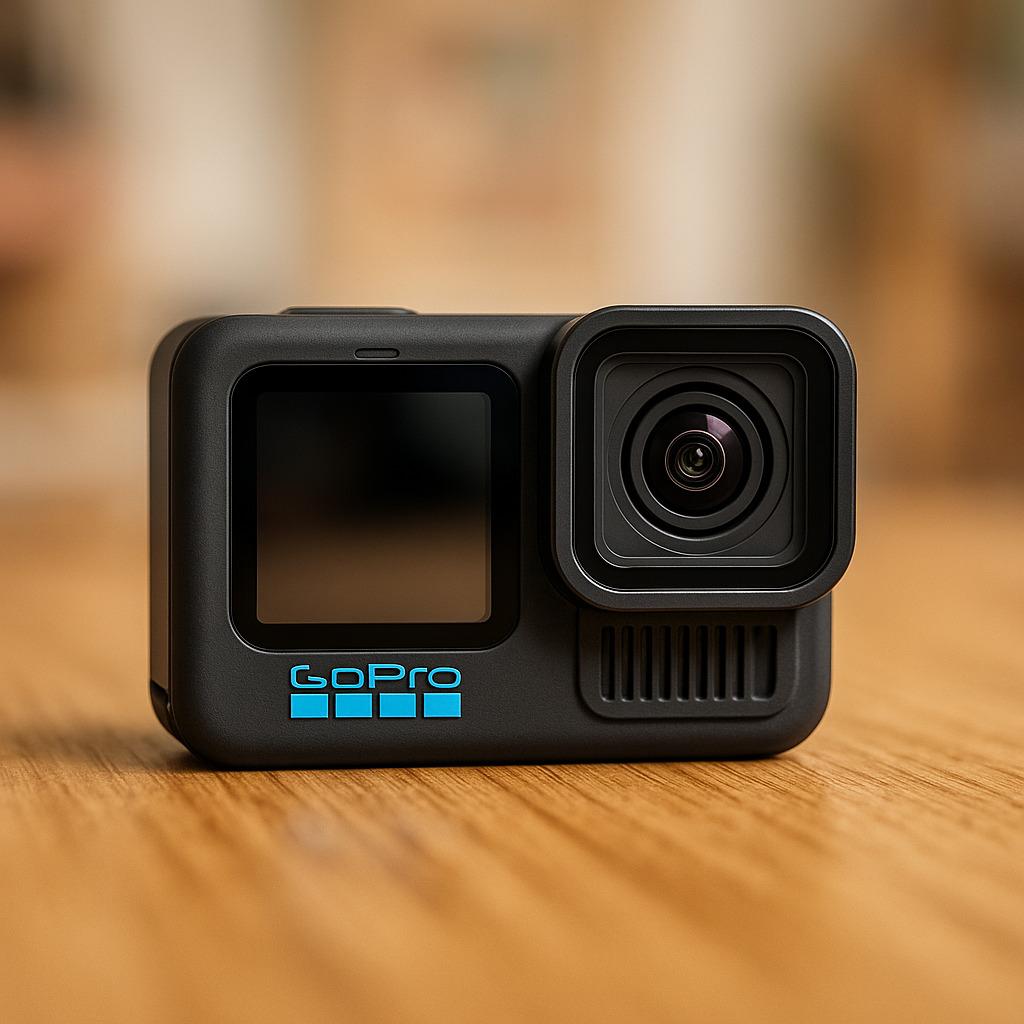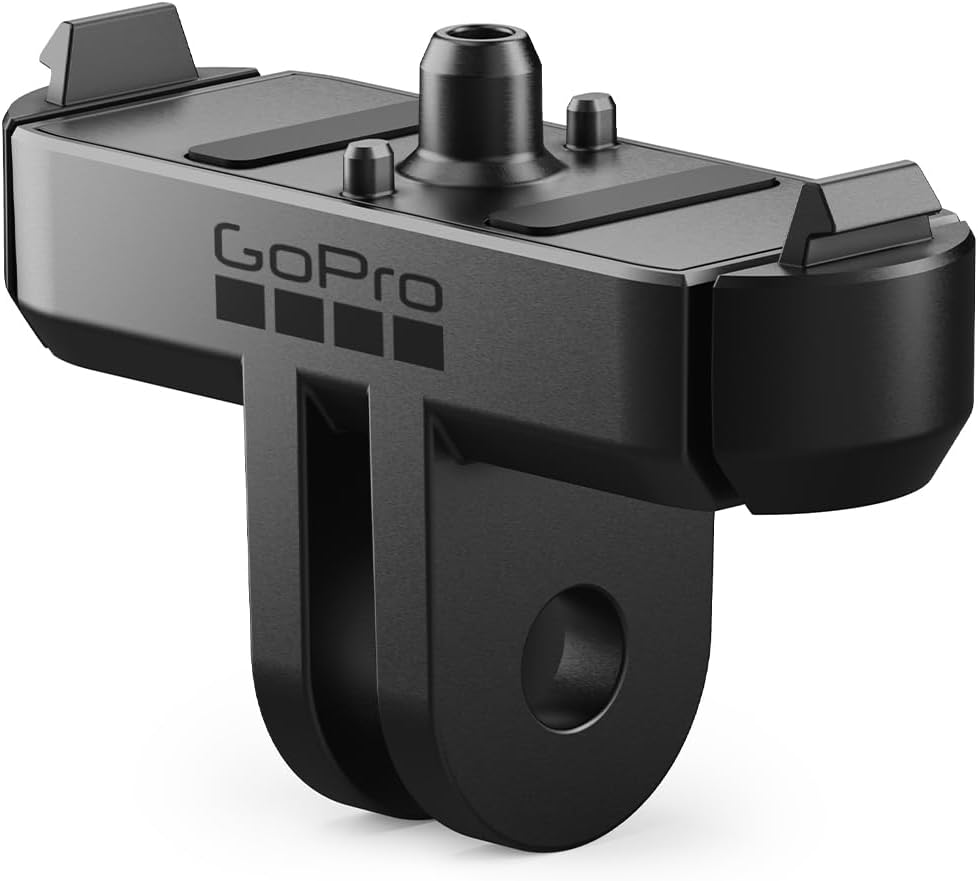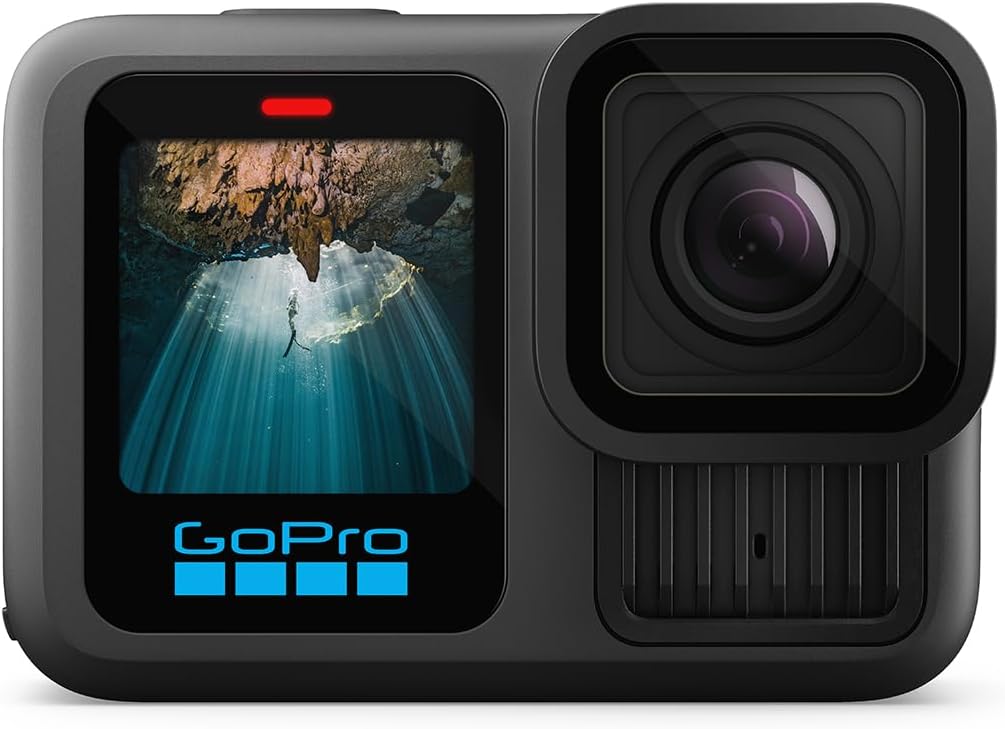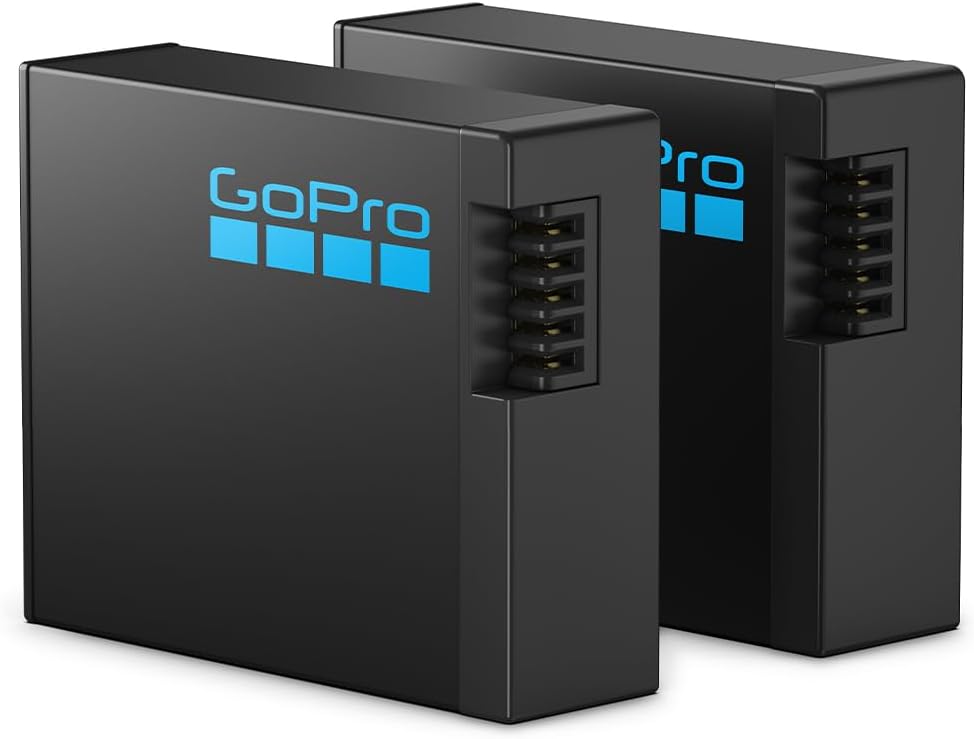
GoPro’s latest and greatest, the Hero 13 Black, arrives with a fascinating proposition: modular creativity paired with familiar core technology. The standout feature is undoubtedly the new HB-Series lens system, bringing interchangeable optics to action cameras for the first time. Alongside welcome returns like GPS functionality and meaningful improvements to battery life and thermal management, the Hero 13 presents itself as an optimistic step in the roadmap, rather than a revolution.
But in 2024’s increasingly competitive action camera landscape, is incremental improvement enough? With DJI’s Osmo Action 5 Pro pushing technical boundaries and offering superior low-light performance at a lower price point, GoPro faces its most significant challenge yet. The Hero 13 must prove that creative modularity and ecosystem excellence can maintain the brand’s premium position against rivals focused on raw specifications.
Price and Availability
Launch Details: The Hero 13 Black launched September 10, 2024, priced at $399.99 / £399.99 / AU$649.95 for the standard bundle - a competitive price point and cheaper than previous GoPro camera launches.
HB-Series Lenses: Prices at launch date - starting at $69.99 for ND filters, ranging up to $129.99 for the Macro Lens Mod. While building a complete collection requires significant investment, each lens offers genuine creative value for specific applications.
Technical Specifications: Familiar Foundation, New Possibilities
| Specification | Hero 13 Black | Key Improvements |
|---|---|---|
| Processor | GP2 | Same proven chip, enhanced efficiency |
| Sensor | 1/1.9” 27.6MP CMOS | Refined processing, familiar quality |
| Weight | 154g | Maintains perfect balance |
| Dimensions | 71.8x50.8x33.6mm | Consistent accessory compatibility |
| Max Video Resolution | 5.3K @ 60fps | Industry-leading resolution maintained |
| Photo Resolution | 27.13MP | Excellent for action photography |
| Battery | 1,900mAh Enduro | Welcome 10% capacity boost |
| Waterproof Rating | 10m (33ft) | Reliable protection maintained |
| Stabilization | HyperSmooth 6.0 | Faster processing, smoother results |
| Key Innovation | HB-Series Lenses | Revolutionary modularity system |
What’s New in the Hero 13 Black
The Hero 13 Black introduces several key innovations while maintaining the reliable foundation that has made GoPro the action camera standard. There’s a lot. We look in-depth below, but checkout the video for a quick run-through of the latest and greatest from the GoPro Hero camera:
Macro Lens Mod
Brings professional macro capability with 4.7-inch minimum focus distance. Perfect for nature documentation and product details, opening creative possibilities previously impossible with action cameras. The optical quality maintains GoPro’s high standards with impressive close-up detail.
Ultra-Wide Lens Mod
Expands field of view to an incredible 177° with brilliant 1:1 aspect ratio flexibility. Ideal for POV shots where maximum environmental capture matters, delivering the immersive perspective that makes action footage compelling.
Anamorphic Lens Mod
Brings genuine cinematic anamorphic effects with characteristic oval bokeh and lens flares. This lens gives action cameras that distinctive Hollywood aesthetic previously reserved for professional filmmaking.
ND Filter 4-Pack
Described as sunglasses for your camera, ND-filters are essential for proper motion blur control in bright conditions. Including ND4, ND8, ND16, and ND32 filters that work seamlessly with the Hero 13’s Motion Blur setting for cinema-quality results. The automatic detection ensures optimal exposure compensation without manual adjustment.
HB-Series Lens Collection and ND-Filters
The HB-Series represents the Hero 13’s most significant innovation, bringing interchangeable optics to action cameras for the first time. Each lens features automatic detection - attach one and the camera instantly recognizes it, adjusting settings accordingly for optimal results.
Magnetic Latch Mounting
A new magnetic mounting option adds convenience for quick positioning without compromising the security of traditional mounts. To be fair, while this magnetic latch mounting is a trick GoPro have learned from their competitors, it’s a welcome addition to the feature set.

The Return of GPS
After its puzzling absence in the Hero 12, GPS functionality returns with enhanced telemetry overlays for speed, altitude, and G-force data.
Improved Thermal Management
A redesigned front panel significantly improves heat dissipation, enabling longer 5.3K recording sessions without overheating. A welcome feature that should’ve been present since the GoPro Hero 11.
Wifi 6 for Faster Connectivity
WiFi 6 support delivers 40% faster file transfers, reducing workflow friction for content creators. Another welcome feature from GoPro for those who use it, but I for one will always prefer the simplicity of sitting down at my desk and plugging into the
Burst Slo-Mo: 720p @ 400fps (15 seconds, 13x slow-motion)
The Hero 13’s Burst Slo-Mo mode captures 720p footage at an incredible 400fps, allowing for dramatic 13x slow-motion effects that reveal details invisible to the naked eye. This mode records for 15 seconds, providing enough footage to capture the perfect moment and extend it into cinematic slow-motion. While the resolution is lower than GoPro’s standard recording modes, the extreme frame rate makes it ideal for analyzing sports techniques, capturing water droplets, or creating dramatic action sequences where every millisecond matters.
Smart Integration
The seamless auto-detection showcases GoPro’s software expertise - each lens is instantly recognized with automatic setting optimization, eliminating the complexity that typically accompanies modular camera systems.
Video and Photo Capabilities: Refined Excellence
Video Specifications
| Resolution | Max Frame Rate | Special Features |
|---|---|---|
| 5.3K (8:7) | 60fps | HDR support, crop flexibility |
| 4K (16:9) | 120fps | HDR up to 60fps |
| 2.7K (16:9) | 240fps | 8x slow-motion |
| 1080p (16:9) | 240fps | Standard slow-motion |
| Burst Slo-Mo | 720p @ 400fps | 15 seconds, 13x slow-motion |
Photo Capabilities
| Feature | Specification | Notes |
|---|---|---|
| Max Photo Resolution | 27.13MP | 8:7 aspect ratio flexibility |
| HDR Photo | Yes | Enhanced dynamic range |
| RAW Support | .gpr format | Professional editing flexibility |
| Frame Grabs from 5.3K | Up to 19.6MP | High-quality video stills |
| Burst Modes | Auto-highlight selection | AI-powered best shot selection |
The Hero 13’s imaging capabilities build on the excellent Hero 12 foundation. The industry-leading 5.3K recording resolution continues to set the standard, while the unique 8:7 aspect ratio remains perfect for social media content creation. GoPro’s color science delivers vibrant, accurate results in good lighting conditions, though low-light performance reveals the limitations of the unchanged sensor.
HyperSmooth: Maintaining Stabilization Leadership
HyperSmooth 6.0 processes footage 4x faster than version 5.0, enabling more aggressive stabilization with reduced crop. The AutoBoost feature intelligently adjusts stabilization levels while maintaining excellent image quality.
Horizon Lock remains unmatched in the industry, maintaining perfect horizontality through 360° rotations. For extreme sports and dynamic activities, this feature alone justifies GoPro’s premium positioning. The stabilization technology continues to set the standard that competitors struggle to match.
Competition Analysis: Technical Innovation vs. Ecosystem Excellence
The Hero 13 faces its most competitive market yet, with rivals pushing different aspects of action camera technology. The comparison reveals fundamentally different approaches to product development.
Squaring Up: the DJI Osmo Action 5 Pro
| DJI’s Technical Advantages | GoPro Hero 13’s Strengths |
|---|---|
| Larger 1/1.3” sensor delivers superior low-light performance with better noise control | Industry-leading 5.3K recording resolution vs. DJI’s 4K maximum |
| Impressive 13.5 stops dynamic range compared to GoPro’s ~11 stops | Revolutionary HB-Series lens ecosystem providing creative flexibility |
| Exceptional battery life reaching up to 4 hours in 1080p recording | Superior 8:7 aspect ratio specifically optimized for social media content |
| Competitive pricing at $349—$50 less than the Hero 13 | Unmatched accessory ecosystem with decades of mount compatibility |
| Lightning-fast 0.3-second boot time for instant recording | Best-in-class stabilization technology with proven reliability |
| Superior performance in challenging lighting conditions | Comprehensive service network and brand support |
A lot of critics are calling this round for DJI’s Osmo Action 5 Pro camera. Look out for a full review here soon!
Versus: Insta360 Ace Pro 2
While the Ace Pro 2 offers impressive 8K recording capabilities, GoPro maintains clear advantages in stabilization quality, build durability, and the comprehensive HB-Series creative system. Insta360’s strength lies in 360-degree content, but for traditional action camera use, the Hero 13’s proven ecosystem provides better long-term value.
The Competitive Reality: Innovation Imperative
This comparison highlights a critical challenge for GoPro. While the brand maintains strengths in ecosystem integration and creative modularity, competitors are rapidly advancing core imaging technology. DJI’s superior low-light performance and faster operation demonstrate what’s possible when companies prioritize technical specifications over incremental refinement.
The action camera market has reached a maturity point where conservative approaches risk losing relevance. Users increasingly expect both creative features and cutting-edge technical performance. GoPro’s strategy of enhancing proven technology while adding modular creativity has merit, but the unchanged sensor and processor feel conservative when rivals push boundaries.
Real-World Performance: Where Each Camera Excels
The strengths of these two behemoths of the action camera space become clear in practical use.
| Hero 13 Excels In | DJI Action 5 Pro Excels In |
|---|---|
| Bright daylight action sports where stabilization matters most | Mixed lighting conditions including low-light scenarios |
| Content creation requiring 8:7 aspect ratio optimization | Extended recording sessions where battery life matters |
| Scenarios demanding creative lens flexibility | Fast-paced situations requiring instant boot times |
| Professional workflows requiring extensive accessory integration | Budget-conscious scenarios where performance per dollar matters |
| Long-term reliability and service support | Technical scenarios where sensor performance is paramount |
FAQ
Do HB-Series lenses work with older GoPros? No, the system requires the Hero 13’s specific auto-detection hardware and firmware integration. This is exclusive to the latest model.
Is the Hero 13 worth upgrading from Hero 12? If you’re excited by HB-Series creative possibilities, need improved battery life, or want GPS functionality, absolutely. If you’re not dying for the new feature set, then the Hero 12 is more than adequate for all of your action camera needs and the Hero 12 still remains excellent value.
How expensive is building a complete HB-Series collection? A full lens kit adds approximately $400 to the camera cost. Most users will benefit more from selective purchases based on specific creative needs.
Should I choose GoPro or DJI for mixed lighting conditions? For varied lighting including low-light scenarios, DJI’s Action 5 Pro offers technical advantages with its larger sensor. For bright daylight action sports, GoPro remains superior.
Will GoPro’s ecosystem advantage last against technical competition? This represents the critical question for GoPro’s future. While ecosystem strength provides current advantages, continued technical conservatism risks losing relevance to more innovative competitors.
Conclusion: Excellence at a Crossroads
The GoPro Hero 13 Black delivers refined excellence with meaningful innovations that enhance the proven formula.
However, this generation’s conservative approach to core imaging technology has created a huge space in the market and DJI have seized that opportunity with both hands, and the audience is most definitely listening.
The unchanged sensor feels particularly conservative when rivals push boundaries with superior hardware at lower prices. GoPro must adopt their strategy in an increasingly competitive landscape.
The action camera space benefits from this competitive pressure driving innovation forward, and as such, I’m really, really looking forward to this September!
This article contains Amazon affiliate links, and I may earn a small commission from qualifying purchases made through these links at no additional cost to you.


